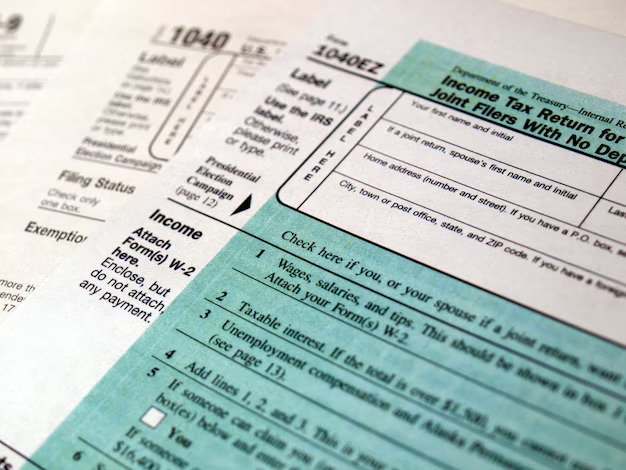Navigating Your Tax Return: Where and How to File Form 1040
Filing your taxes can often feel overwhelming, especially with the intricacies and forms you need to tackle. Among them, Form 1040 is central to many U.S. taxpayers, acting as the primary document to report personal income and calculate tax obligations. One of the common stumbling blocks is determining where you should file this form. With tax rules evolving and deadlines looming, understanding the process can ease anxiety. This guide dives deep into the "where" and "how" of filing Form 1040 with clarity and ease.
📬 Where Exactly Should You File Form 1040?
Filing Location depends on several factors, including whether you’re filing electronically or by paper, the state you live in, and whether you’re including a payment. Here's the breakdown:
Filing Electronically
For many, the safest and most efficient way to file Form 1040 is electronically. E-filing offers several advantages:
- Speed: Faster processing and quicker refunds.
- Accuracy: Built-in checks reduce errors.
- Confirmation: Immediate acknowledgment from the IRS.
There are various e-filing options:
- IRS Free File: A web-based platform offered in partnership with private companies for low- to moderate-income taxpayers.
- Commercial Tax Software: Popular brands offer user-friendly interfaces guiding you through to ensure compliance and accuracy.
- Paid Tax Professionals: Ideal if your financial situation is complicated, offering peace of mind for a fee.
Mailing Your Form
If you prefer traditional paper filing, you need to mail your Form 1040 to the appropriate IRS address. This varies based on your residential state and whether you're enclosing a payment. The IRS provides updated addresses on its website, but here are some key guidelines:
- Enclosing Payment: The address may differ if a payment is included, and you generally use a dedicated processing center.
- No Payment: A different address is used, usually a service center nearest to your location.
- P.O. Box vs. Street Address: Some forms go to a P.O. Box; others to street addresses. Ensure you have the correct one before mailing.
Using a Tax Professional
Should you opt to work with a CPA or tax preparer, they will often handle the filing logistics. Their expertise can further ensure that your Form 1040 goes to the correct location, electronically or via post, reducing your stress and ensuring compliance.
🔎 Tips for Choosing the Right Filing Method
When deciding the best method for filing your Form 1040, consider:
- Complexity of Tax Situation: More complex tax scenarios might benefit from professional help or specific software.
- Comfort with Technology: If paper feels more reliable to you, traditional methods will be your choice, but don't shy away from e-filing opportunities.
- Deadline Proximity: E-filing allows last-minute completion, while mailing requires more lead time.
🗂 Key Documents to Gather Before Filing
Having your documents organized prepares you for a seamless filing experience. Here's what you typically need:
- W-2s and 1099s: Documenting wages and other income.
- Interest and Dividend Statements: From banks or investments.
- Mortgage Interest and Property Taxes: For deductions.
- Receipts: Especially for significant deductions like charitable contributions or medical expenses.
- Social Security Numbers: For all individuals listed on your return, including dependents.
📝 Filing Form 1040: Steps to a Smooth Process
Step 1: Determine Your Filing Status
Choosing your filing status is critical as it affects your tax bracket and exemptions available. Options include:
- Single
- Married Filing Jointly
- Married Filing Separately
- Head of Household
- Qualifying Widow(er) with Dependent Child
Step 2: Fill Out the Form
Use the organized documents to complete the form. Be aware of all the sections, ensuring all income is reported, and each deduction is applied correctly.
Step 3: Double-Check for Accuracy
Errors can delay refunds or trigger audits. Use resources to ensure accuracy:
- IRS Guides: Help navigate the complexities.
- Tax Software Checks: Automatically scan for mistakes.
Step 4: Submit Your Form
Finalize your filing method — electronically for speed or by post if preferred. Ensure all accompanying forms and schedules are included when mailing.
🔗 Frequently-asked Questions Regarding Form 1040
What Should I Do If I Make a Mistake?
Mistakes happen. If you catch an error post-submission, the IRS Form 1040-X allows for corrections. It's best to file this as soon as discrepancies are discovered to avoid complications.
Are There Any Special Considerations for Military or Overseas Filers?
Yes, specific rules apply for military personnel or those residing abroad. Typically, electronic filing options are available, and unique postal addresses apply for mailed returns, considering the logistical challenges.
How Do Filing Deadlines Impact My Submission?
Filing deadlines vary slightly each year. Make note of the April deadline, filing promptly to avoid penalties, or request extensions if necessary.
📝 Summary: Filing Form 1040 Simplified
Here's a handy summary to keep your Form 1040 filing on track!
- 📬 File electronically for speed and accuracy.
- 📖 Gather documents early to avoid scrambling.
- 🏠 Select correct mailing address based on state and payment inclusion.
- 🚀 Consider professional help for complex situations.
- 📅 Meet deadlines to prevent penalties.
Filing your Form 1040 need not be a daunting task. With preparation, understanding of your filing options, and accurate completion, handling your annual tax obligations can become a stress-free routine. Empower yourself with this knowledge, and tackle tax season with confidence!
